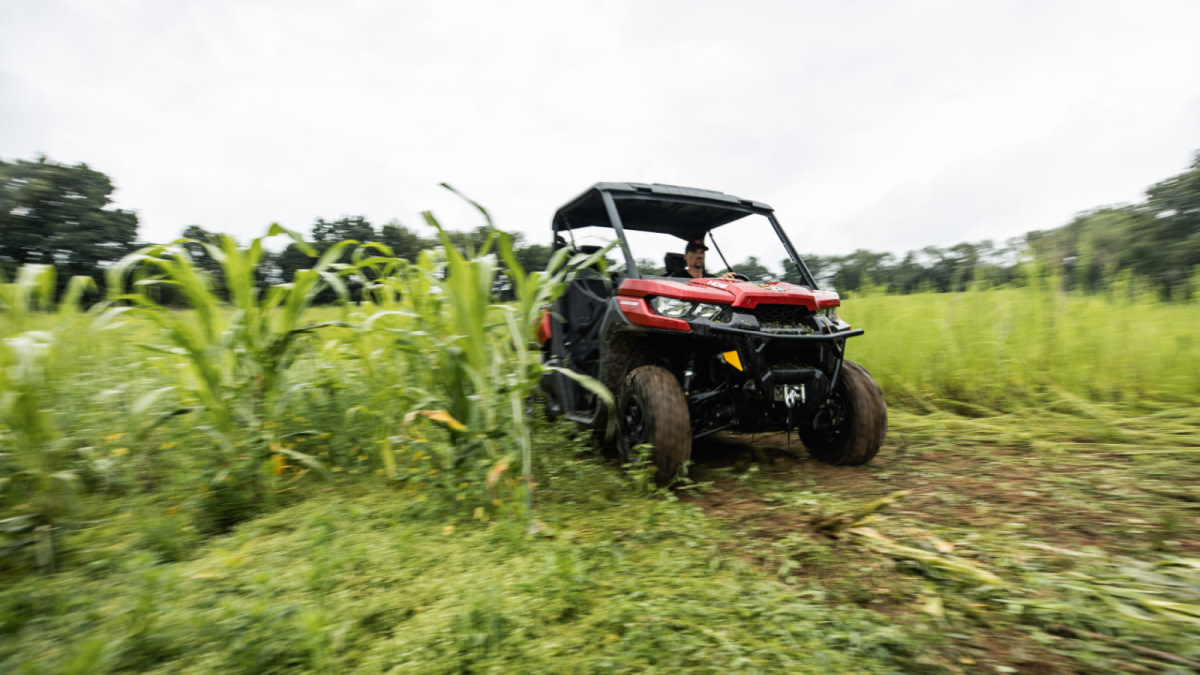
A consistently favorite topic among whitetailers is food plots. Before you get your hopes up about some groundbreaking, revolutionary seed mix or soil amendment strategy, I need to provide a disclaimer: I’m far from a food plot expert. But with some trial and error, plenty of reading, and quality advice from experienced friends, I’ve been able to find my way to some success in creating a few effective food plot strategies. I’ve developed a foundational belief that choosing the right location and shape are far more impactful than plot size or plant type.
The Right Mix I won’t start the debate of which food plot mixes are best. Preferred types and mixes are relative to climate, available forage, and ultimately the personal preference of the planter. When planning food plots an acre or less in size, planting something that can withstand heavy feeding while maintaining its attractiveness through the fall and winter is critical. My go-tos are a variety of clover mixes, cereal grains, or a combination of the two. These provide a nice complement to the larger destination ag fields and last well into winter.
Planting to the Tree Like the right seed choice, the correct location is relative to the layout of a specific property and personal preference. For me, the right area is a secluded spot back in some cover that will encourage daylight activity. But getting in tight to security cover can be tricky. Your entry and exit routes need to be carefully planned and executed so you don’t put too much pressure on the staging area.
Equally as important is your stand position. Consider how the location of the food plot situates with the predominant wind directions, thermals, how terrain affects the wind currents, and the most likely direction of travel for doe groups and bucks. Understanding these factors will likely narrow down your stand location to one or two options. Once you’ve pegged the best locations for the area, it’s time to start designing your plot to put that buck in your lap in daylight.
Visualizing Success Think about the moment of truth with a buck in range, utterly unaware that you’re in his world. Start by unpacking the scenario and all that goes into making it a reality. In thinking about which planting shape will best suit the situation, be confident where a buck will likely enter the plot based on wind and bedding location.
Next, consider how you can use the plot to funnel deer past your ideal stand location. The goal is to encourage daylight movement while not lingering too long. Of course, this isn’t a perfect science. You’re dealing with wild animals after all. Now that you’ve chosen the right tree, it’s time to consult onXmaps.
Digital mapping apps and software like onX are tremendous assets for building food plots. The distance measuring tool and the ability to draw shapes allows you to be creative with the planning process. Using these tools, you can keep the size of your plot in check without getting carried away or planting too broadly. Keep the plot within shooting range of your stand to decrease the chance of a buck getting by out of range.
A few years ago, I picked up the guidance to not plant to the edge of the cover. A 5-yard buffer around the plot seems to entice deer out a bit more to start feeding rather than standing back and feeding on the edge.
Now, let’s get into some of my favorite small food plot shapes for getting deer into range. There’s no doubt they work, but it’s still about being there on the right day when he decides to make a daylight appearance.
The Hourglass This plot is shaped like an hourglass with two wider ends and a bottleneck in the middle. This is a good strategy around larger bedding areas where the entry points are more difficult to pinpoint. The wider ends give a buck a broader view of entry, which they seem to like. As they transition through the plot, the shape naturally funnels them into the narrow middle section. Ideally, your stand placement would be either at the mouth of the thin section or in the middle to put a deer well within range as they pass through the pinch point, opening up into the other end of the plot.
The Field Goal The field goal plot offers bucks options. The goal here is to lay out the plot in a way where the deer enter from the top of either side of the uprights or “U,” and your setup would be at the bottom of the “U” along the crossbar.
This provides deer some separation from one another. In regions with high deer densities, putting a buffer of taller foliage or brush between the two uprights can give a sense of security where they aren’t bunched up in a small area. As a buck filters down either side of an upright, they wind up at the crossbar in range of your stand. Whether they choose to walk straight through or bend around and travel broadside in front of you, try to set it up where you can shoot either end from the middle of the crossbar section of the plot.
The Hallway The hallway is an excellent choice if you need options. For the rut, it provides secluded feeding for harassed does, and bucks can grab a quick bite as they cruise through. You can adjust your stand position based on travel patterns, entry and exit, and wind direction from one side to the other.
This works well on a new property where there’s little knowledge of preferred travel routes. The flexibility to set up at any point on the longer sides or in the corners offers welcome versatility. Make it wide enough where a buck will feel comfortable working one edge or the other, while still allowing you to shoot the width of the plot.
_Feature image via Captured Creative. _





